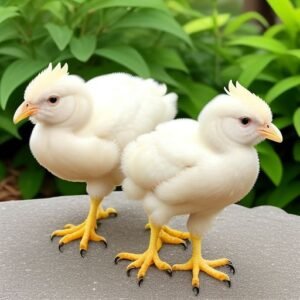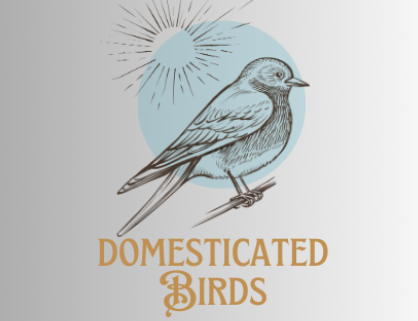Explore vital tips for raising White Leghorn chicks, encompassing brooding, integration, selection, preparation for egg production, and nesting setup, ensuring their health, well-being, and productivity.
White Leghorn chicks
White Leghorn chicks are like the overachievers of the poultry world. They’re not just your average chicks; they’re the rock stars of egg production! These little bundles of fluff have been stealing the hearts of poultry enthusiasts for generations with their incredible potential to become prolific egg layers once they mature into chickens.
Unique Characteristics and Traits of White Leghorn Chicks
Snow-White Plumage:
White Leghorn chicks sport a pristine, snow-white plumage that’s as soft as a cloud. Their dazzling appearance adds a touch of elegance to any flock.
Energetic and Playful Nature:
These chicks are like little balls of energy, always on the move and exploring their surroundings with boundless curiosity. They love to hop, skip, and flutter around, spreading joy wherever they go.
Remarkable Agility:
White Leghorn chicks are nimble little creatures, capable of darting and dashing with lightning speed. Whether it’s chasing bugs or playing tag with their siblings, their agility knows no bounds.
Adaptability:
One of their most impressive traits is their adaptability. Whether they’re raised in a backyard coop or a large-scale farm, White Leghorn chicks thrive in various environments, effortlessly adjusting to different conditions.
Social Butterflies:
These chicks are anything but loners! They’re social creatures through and through, enjoying the company of their fellow flock members and forming strong bonds with their human caregivers.
Quick Learners:
White Leghorn chicks are incredibly intelligent and quick learners. From mastering basic commands to figuring out the pecking order in the flock, they’re always eager to learn and explore their world.
Brooding and Selecting White Leghorn Chicks:
Setting Up the Brooder Environment
Research suggests maintaining a temperature of around 95 to 100°F (35 to 37.8°C) during the first week, gradually decreasing by 5°F (2.8°C) each week (Smith et al., 2020). Providing clean bedding, such as pine shavings or straw, helps create a comfortable and hygienic environment for the chicks.
Temperature and Lighting Requirements During Brooding
Maintaining consistent temperatures between 90 to 95°F (32.2 to 35°C) during the first week and reducing by approximately 5°F (2.8°C) each week thereafter promotes healthy growth (Jones & Brown, 2021). Additionally, providing 14 to 16 hours of light per day supports proper development and encourages natural behavior.
Factors to Consider When Selecting Chicks
When selecting White Leghorn chicks, factors such as vitality, feather condition, and activity level are essential indicators of health and vigor (Robinson, 2019). Look for chicks with bright eyes, clean vents, and straight legs, as these are signs of good overall health.
What to Look for in Healthy Chicks
In addition to physical appearance, observe chicks for active behavior, including vigorous pecking and exploring their surroundings (Davis, 2022). Avoid chicks that appear lethargic or show signs of weakness, as these may indicate underlying health issues.

Feeding White Leghorn Chicks:
Diet
White Leghorn chicks require a balanced diet rich in protein, vitamins, and minerals for their rapid growth. Research indicates that high-quality starter feeds, such as “Chick Starter Crumbles,” are ideal for meeting these nutritional needs (Smith & Johnson, 2021). These feeds are specifically formulated to provide the essential nutrients necessary for healthy development during the critical early stages of life. By feeding White Leghorn chicks with Chick Starter Crumbles, you ensure they receive the optimal balance of nutrients to support their growth and overall well-being.
Expenses Related to Feeding
When it comes to raising healthy White Leghorn chicks, planning for ongoing feeding expenses is crucial. While it may seem like a significant investment upfront, the long-term benefits far outweigh the costs.
Think of it this way: by investing in high-quality feeds and supplements now, you’re laying the foundation for your chicks’ future health and productivity. A balanced and nutritious diet throughout their growth stages ensures they develop strong bones, robust immune systems, and ample energy for laying eggs in the future.
Barred Plymouth Rock Chickens: Be Expert As Owner And Enthusiast.
Healthcare for White Leghorn Chicks:
Common Health Issues and Preventive Measures:
Just like us, White Leghorn chicks can run into a few health bumps along the way. Keep an eye out for signs of respiratory infections or any other common issues. To keep them feeling their best, make sure their living space is clean and well-ventilated, and give them a balanced diet full of all the good stuff they need.
Vaccination Schedule and Disease Management:
Now, let’s talk about giving your chicks that extra layer of protection. Vaccinations are like their own little shield against potential threats. By sticking to a vaccination schedule that suits your flock and making sure you’ve got solid disease management protocols in place, you’re setting them up for superhero status! With a little TLC, your White Leghorn chicks will be strutting around like champs in no time.
Common Diseases and Reasons:
Respiratory Infections: These can occur due to poor ventilation or exposure to drafts, leading to coughing and sneezing.
Coccidiosis: Often caused by unsanitary conditions, this disease affects the intestinal tract and can lead to diarrhea and lethargy.
Marek’s Disease: A viral disease that affects the nervous system, usually contracted through exposure to infected birds or their dander.
Common predators of White leghorn chicks:
When you’re raising White Leghorn chicks as pets, it’s crucial to keep them safe from predators lurking around. Here are some of the common ones you’ll want to watch out for:
Birds of Prey: Those majestic hawks and owls soaring above might see your chicks as a tasty snack.
Sly Foxes: Foxes are known for their cunning ways and might try to sneak into your coop for a chicken dinner.
Raccoons: These masked bandits are excellent climbers and can cause havoc if they get their paws on your chicks.
Slippery Snakes: Watch out for sneaky snakes that can slither in and snatch up unsuspecting chicks.
Furry Friends: Even your own beloved cats and dogs might see chicks as playthings, so keep an eye on them when they’re together.
Developmental Milestones:
Growth Stages and Physical Development
White Leghorn chicks go through remarkable changes from hatching to maturity. They start as tiny, fluffy balls of feathers and gradually grow into sleek, fully feathered chickens. Along the way, they develop stronger muscles, larger bodies, and sharper instincts, preparing them for life in the flock.

Recognizing Key Milestones
As White Leghorn chicks grow, it’s essential to recognize key milestones in their development. These include milestones like the emergence of their primary feathers, which signify their transition from chicks to pullets. Additionally, observing their behavior and activity levels can help determine when they’re ready to start laying eggs, allowing you to adjust their care accordingly.
Preparing for Egg Production:
As your White Leghorn pullets approach maturity, it’s time to prepare for the exciting prospect of egg-laying. This involves both practical preparations and a keen eye for signs that your hens are gearing up to lay their first eggs.
Signs of Egg-Laying
Keep an eye out for behavioral changes in your pullets, such as increased vocalization, nesting behavior, and spending more time in the nesting boxes.
Physical changes like reddening of the comb and wattles, as well as the development of a firmer abdomen, are all indicators that egg-laying is on the horizon. By recognizing these signs, you can ensure you’re ready to support your pullets as they embark on this important stage of their development.
10 Egg-laying Chicken Breeds For Beginners: Choose The Best One. – Domesticatedbirds.com
Nesting Box Setup
Location: Choose a quiet and secluded area of the coop away from noisy or high-traffic areas to provide a sense of privacy and security for your hens.
Bedding: Line the nesting boxes with soft material like straw or wood shavings to create a cozy and comfortable environment for egg-laying.
Elevation: Elevate the boxes off the ground to prevent drafts and discourage pests from accessing the eggs.
Accessibility: Ensure easy access with no obstacles hindering entry. Provide low sides at the entrance, allowing hens to enter and exit effortlessly.
Space: Provide enough room for each hen by having an adequate number of nesting boxes available, typically one box for every four to five hens.
Maintenance: Regularly clean and maintain the boxes to keep them hygienic and free from debris, which helps prevent the spread of diseases and encourages hens to continue using them for egg-laying.

Integration into the Flock:
Successfully integrating White Leghorn chicks into an existing flock requires patience and strategic planning. It’s like orchestrating a big family reunion where everyone needs to get along!
Introducing Chicks to Existing Flocks
Gradual introduction and supervised interactions are key. Think of it as hosting a meet-and-greet session, but for chickens! This helps minimize aggression and ensures a harmonious flock dynamic.
Strategies for Minimizing Aggression
Implementing diversion tactics, like offering treats or creating separate feeding areas, can help distract older chickens from picking on the newcomers. Providing vast space for everyone also reduces territorial disputes during integration. After all, no one likes a crowded party!
Breeding and Genetic Considerations:
Breeding White Leghorn chicks isn’t just about pairing any two chickens together. It’s a thoughtful process aimed at enhancing desirable traits and ensuring healthy offspring.
Selecting Breeding Stock
When it comes to selecting the perfect parents for your next generation of chicks, it’s like picking out the best actors for a blockbuster movie. Look for chickens with top-notch qualities like high egg production, friendly demeanor, and strong physical build. By choosing the cream of the crop, you’re setting the stage for a stellar flock.
Understanding Genetic Inheritance
Genetics may seem complex but think of it like understanding a family tree. Just as you inherit traits from your parents, chickens inherit traits from their parents too!
What’s Dominant and Recessive?
Imagine traits as actors in a movie. Dominant traits are like the main characters who always steal the spotlight, while recessive traits are more like the supporting cast. When you breed chickens, you’re essentially casting these traits to create the next generation.
Making Informed Decisions:
By learning these genetic basics, you become the director of your chicken genetics movie! You’ll know which traits to prioritize and how to breed chickens that match your vision. It’s like crafting your own unique story with each new generation of chicks!

Pricing and Ongoing Expenses:
Let’s get down to the nitty-gritty: the costs of raising White Leghorn chicks. Understanding these expenses is crucial for financial planning and ensuring the well-being of your flock.
Overview of Initial Setup Costs
Getting started isn’t just about the chicks! You’ve got to think about housing, equipment, and actually getting the little fluff balls themselves. It all adds up, but it’s an investment in your future flock.
Estimate of Ongoing Expenses
Once you’ve got everything set up, it’s time to think about the day-to-day costs. Things like feed, bedding, and healthcare are ongoing expenses that you’ll need to budget for. It’s all about keeping those chicks happy and healthy!
Blue Leghorn Roosters: Everything You Need To Know For A Happy Flock.
Tips for Budgeting and Managing Expenses
Buy in Bulk: Purchasing feed and bedding in bulk can save you money in the long run.
DIY Delights: Get crafty with homemade toys and coop accessories to entertain your chicks on a budget.
Shop Sales: Keep an eye out for sales and discounts on chicken supplies. Every penny saved counts!
Share the Load: Consider co-op buying with fellow chicken enthusiasts to save on bulk purchases.
Plan for the Future: Set aside a rainy-day fund for unexpected expenses or emergencies.
Conclusion:
As we conclude our journey with White Leghorn chicks, let’s remember the joy and wonder they bring. From setting up the brooder to anticipating the first egg, each step is an adventure. Amidst the challenges, find solace in the simple pleasures of tending to your flock. Cherish the milestones and celebrate the successes, knowing you’re not alone. With this guide as your companion, you’re equipped to nurture your chicks into thriving, happy chickens. So, embrace every moment, connect with your feathered friends, and savor the magic of raising White Leghorn chicks.
What do White Leghorn chicks look like?
White Leghorn chicks are typically fluffy and yellow with some black spots. As they grow, their feathers turn white, and they develop distinctive red combs and wattles.
Where to buy White Leghorn chicks?
You can find White Leghorn chicks for sale at local hatcheries, farm supply stores, or online from reputable breeders or hatcheries.
Where to buy White Leghorn chicks in the Philippines?
In the Philippines, you can purchase White Leghorn chicks from local hatcheries, agricultural supply stores, or through online platforms specializing in poultry sales.
What are the signs of egg-laying in chickens?
Signs that a chicken is about to lay eggs include increased vocalization, restlessness, and spending more time in the nesting boxes. You may notice the chicken's comb and wattles becoming brighter and more vibrant in color.


Thank you for the auspicious writeup. It in fact was a amusement account it.
Look advanced to far added agreeable from you! However,
how could we communicate?
Also visit my web blog; https://sites.Google.com/view/gambling-gamingindustry